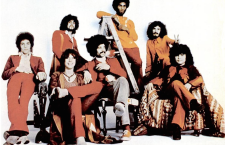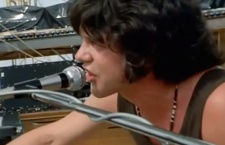Gregg Rolie, a founding member of Santana and then of Journey, shares unique insights into songs from across a Rock and Roll Hall of Fame career – some of them famous and some more obscure.
Find out how Journey actually almost scrapped one of its most memorable Rolie-era tracks, how former members of the Santana band completed a reunion album in less than two weeks of feverish writing inside a rustic north California cabin. How grunge washed out one promising project, why early Journey would have fit in on tour with Phish, and how Eddie Money hit with a song that Rolie did first.
Oh, and guess which radio favorite Rolie nailed on the very first take? …
“ANYTIME,” with Journey (INFINITY, 1978): Journey’s fourth album, the last with original drummer Aynsley Dunbar before Steve Smith took over, became a triple-platinum smash with the introduction of second lead singer Steve Perry. This song is notable for its layered harmony vocals, the trademark of new producer Roy Thomas Baker, who had previously worked with Queen. Baker achieved this effect by having Perry and Rolie double track their parts, a time-consuming new approach that almost derailed “Anytime.”
GREGG ROLIE: When we recorded that, we did just the music, and we almost didn’t finish it. Remember, we came to this having been a jam band. When we finished the music, we listened to all of the tracks, and it didn’t have the fire that we were used to. We had never spent too much time doing all of the vocals. As soon as the vocals were put in, though, the song came alive. I’m glad we didn’t can it! (Laughs.)
“SOUL SACRIFICE,” with Santana (SANTANA, 1969): Credited to the entire band as a composition, this nearly relentless instrumental builds outward to Carlos Santana’s boiling, angular bursts of guitar from a house-levelling rhythmic core: There’s the chugging B-3 line by Rolie, a hailstorm of percussive delights and the stunning, almost acrobatic drumming of Michael Shrieve. “Soul Sacrifice” provided a signature moment in the Santana band’s breakout performance at Woodstock, and remains a concert staple.
GREGG ROLIE: That song is just infectious, and I think that’s the reason it connected with that generation and the generation that came after. I co-wrote and co-arranged it. The rhythm is unbelieveable. That was all built on jamming, and that was the way we played. We made parts out of the things we jammed. It’s become a classic; I hate to use that term, but it has. At the time, though, we were just trying to connect — and we did.
“A MILLION MILES AWAY,” with Abraxas Pool (ABRAXAS POOL, 1997): A key Rolie vocal from this forgotten-gem reunion album of ex-Santana band members, including Shrieve, Neal Schon, Jose “Chepito” Areas, Alphonso Johnson, and Mike Carabello. “Million Miles” makes a definitive argument in general for the group’s sometimes overlooked impact on the broader Santana sound, and in particular for Rolie’s talents as a singer, performer, composer and producer.
GREGG ROLIE: A great song, and one of the few of mine that I listen to regularly. I never do that. Neal, Michael and myself wrote that. The creation of that music happened at a little cabin in California, and believe me, it was a cabin. The sound went all over Marin County, though we never got a complaint. We wrote all of that stuff in 10 or 12 days. It was just pouring out of everybody.
“SOMEDAY SOON,” with Journey (DEPARTURE, 1980): Thoughtfully optimistic, this soaring ballad appeared on Journey’s sixth release, the last with founding member Rolie — who was replaced by Jonathan Cain after a wildly successful tour chronicled in 1981’s Captured. Reaching the Top 10 on the Billboard album charts, Departure was, at the time, the band’s highest charting effort ever. “Someday Soon” remains one of the final, and one of the more memorable, vocal collaborations with both Perry and Schon.
GREGG ROLIE: I remember (Journey manager) Herbie (Herbert) calling me up and saying there was a college that wanted to use this song in their music department to show good songwriting. I said, ‘Really?! Maybe I will finally get a degree of some sort.’ (Laughs.) The thing is, that song was so difficult to write. I ended up looking out the window, and the lyrics just wouldn’t come. Finally, that’s what popped into my head — someday soon.
“I WANNA GO BACK,” solo (GREGG ROLIE, 1985): A deep cut from Rolie’s accessible, largely overlooked debut, recorded after a few years away from the business spent starting a family. The track includes Starship producer Peter Wolf on keyboards, as well as Jason Scheff — who would go on to replace Peter Cetera in Chicago — as a background singer. Of course, “I Wanna Go Back” was remade by Eddie Money a year later and, revved up considerably from its tender melancholy here, shot to No. 14 on the Billboard Hot 100.
GREGG ROLIE: I did it first, and he had a hit with it. That’s the way it goes. I learned a lot, doing that first solo album. Before I had always relied on a band; I never had to design the whole thing. They were always a team effort, but when you go solo, it’s totally different. That was a new experience for me. I got better on the second one.
“SPACEMAN,” with Journey (NEXT, 1977) The opener on Journey’s third release, an album that sought to advance the band’s central prog rock/fusion formula. On “Hustler,” Journey toughened its sound considerably; on tracks like “Spaceman,” we hear the first flowerings of a pop sensibility, as well. Yet, Next reached just No. 85 on the Billboard Pop Album charts. So the four-piece group (Rolie, Schon, Dunbar and bassist Ross Valory) began searching for new blood. They briefly added Robert Fleischman — who arrived shortly after this album’s release, toured with the band and even received co-writing credit on three songs for Journey’s following album — but eventually settled on Steve Perry.
GREGG ROLIE: A really good melody, with lyrics by Ansley Dunbar. That was one of his first attempts at writing lyrics. You know, a lot of metal players connected with that album. Songs like “Hustler” — I wrote the music for that — had such a rough edge to it. They picked up on that stuff. The way I look at the early Journey stuff is, if we played that now, we’d be out with Phish, or the Matthews Band. We were a great jam band.
“I’VE GOT A LOT TO LEARN ABOUT LOVE,” with the Storm (THE STORM, 1991): The initial single from a reunion project for Rolie, Smith and Valory, this billowing power ballad peaked at No. 6 on the Mainstream Rock Tracks chart and at No. 26 on the Billboard Hot 100. Rolie shared vocal duties with Kevin Chalfant (the Alan Parsons Project) in a group that also included Schon clone Josh Ramos on guitar. The project was derailed, however, by the period’s twin movements of harder, more confrontational music — grunge and rap. Smith subsequently left the project, leading Rolie to Ron Wikso, who’s still at the drums in the Gregg Rolie Band.
GREGG ROLIE: Playing with Stevie and Ross again, it was like riding a bicycle. Steve Smith is a great drummer, and Ross is Ross. Had Interscope (which subsequently struck a deal to distribute Death Row Records, home of Dr. Dre and Snoop Dogg) not changed their style away from that kind of music, it would have been a different story. Two years earlier, and we’d be talking about something else. But that style of music went out the window, and so did we.
“BLACK MAGIC WOMAN,” with Santana (ABAXAS, 1970): Originally written as a single by Peter Green for the original, bluesier incarnation of Fleetwood Mac in 1968, this song was reborn two years later in the hands of the Santana band. “Black Magic Woman,” with a career-making vocal by Rolie, would go all the way to No. 4 in the U.S. and, paired with Gabor Szabo’s “Gypsy Queen,” push Abraxas to the top of the charts, as well. The 1970 release eventually earned quadruple platinum sales.
GREGG ROLIE: Just a special song. Sometimes, a singer just connects with a song, and that was it. The song had such a realism to it. (So much so, that Rolie has included a new stripped-down version on his newest EP release.) Mike Schreive turned me on to Fleetwood Mac when they were a blues band. He knew I liked Peter Green, from when he was with John Mayall’s Bluesbreakers. I thought to myself, I could really sing this. When it came time to record, I sang it once in the studio — one of the few times I did that — and it was done.
- Nick DeRiso’s Best of 2015 (Rock + Pop): Death Cab for Cutie, Joe Jackson, Toto + Others - January 18, 2016
- Nick DeRiso’s Best of 2015 (Blues, Jazz + R&B): Boz Scaggs, Gavin Harrison, Alabama Shakes - January 10, 2016
- Nick DeRiso’s Best of 2015 (Reissues + Live): John Oates, Led Zeppelin, Yes, Faces + others - January 7, 2016




Loved hearing Gregg’s insight and take on all the songs! I am also very happy he got his due and was inducted into the R&R Hall of Fame! Would love to see him inducted again as the Founding member of one of my favorite bands! Gregg has pretty much been the sountrack to my life! I am always looking to hear what he’s doing next!
I loved his take on Cool Little Mama!
Keep Rocking Gregg!!!
What a fantastic and enlightening interview. Gregg is absolutely right that the original Santana line-up was a band and not just one guy. Indeed, what was unique about the sound that was produced by Santana was the interplay between the different elements — percussion, keyboards, and guitar. Which, of course, made it more than the sum of the parts. Bring your band to the UK, Gregg. How about Glastonbury next year? You will go down a storm (no pun intended) — the younger kids wil not have heard anything like it.